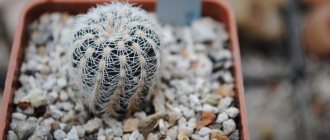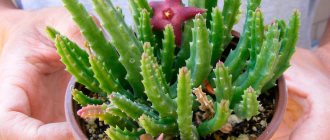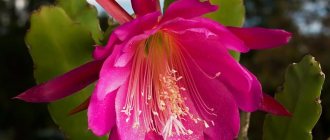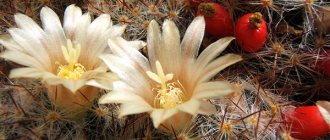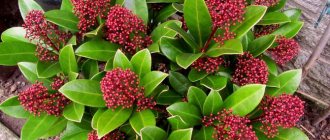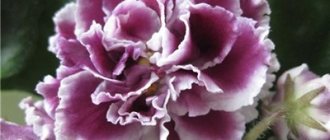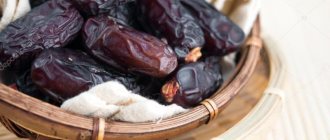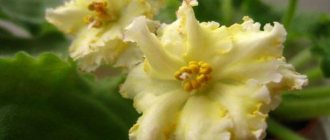Gymnocalycium is a popular genus of the Cactaceae family, covering large areas of Argentina, southern Bolivia, much of Paraguay, Uruguay and surrounding areas of Brazil.
Author of the article
Eduard Dmitriev
Florist and lover of indoor and garden plants.
What does a Gymnocalycium cactus look like?
The plant belongs to the Cactus family. From Latin the name Gymnocalicium is translated as “bare calyx”. The flowers are not covered with hairs, but are covered with smooth scales. The height of the trunk can vary from 1.5 to 7 cm. The diameter can be 2.5-15 cm. The shape of the above-ground part is round or flat. Flowers can have different shades.
Appearance
There are more than 150 species of Gymnocalycium that share the same botanical description. This is a perennial plant with dense roots that go deep into the ground. The aerial part is dark green in color, and the skin itself is smooth to the touch.
Additional Information! Varieties have been selectively bred whose shoots can be yellow, red or orange.
The most common types of Gymnocalycium:
- Reductum;
- Friedrich or Japanese;
- Baldianum or Balda;
- Mikhanovich;
- Horst.
Appearance of one of the varieties
There is also a separate group of the species, which is formed from several plants similar in shape and size.
Botanical description of Gymnocalycium baldianum (Baldianum)
Cactus hymnocalicium is a succulent with a flattened, spherical stem. It comes in different colors: brown-green, brownish, gray or green with silver.
The thickness of the stem is 4-15 cm, which is two times less than its height. It has 10-32 vertical ribs, which are covered with areoles with tufts of long spines.
At the top of the stem part, flowers of Gymnocalycium Balda (May-November) are formed in the form of a bell. The diameter of the inflorescences is 2-7 cm. They have several rows of lanceolate-like petals, without spines and with closed cups. Coloring may be different:
- red;
- raspberry;
- yellow;
- creamy.
The fruits of hymnocalicium are similar in appearance to eggs and are covered with scales on top.
Shoots have a short, cylindrical appearance . The ribs contain up to 20 stripes with a twisted spiral. They often have tubers located below the surface of the areole. The spines are 1.25-3.8 cm long. In some cases, the ends may bend towards the stem and usually they stretch along the sides or bottom.
As soon as the flower fades, an egg-shaped fruit appears on it. When ripe, the color of the fruit is green, red or purple.
Common varieties
How to plant a cactus: examples at home
This type of cactus is widespread in floriculture. Therefore, many varieties have been selected for decorative cultivation, among which are the most popular:
- Gymnocalycium Reductum (humpbacked) is the largest representative of the species. As it grows, the shape and color of the stem changes. The plant grows from a ball into an oval, which is divided by furrows. Reductum can grow up to half a meter. The spines are arranged radially. At the top of each segment there is a bunch with sharp long spines.
- Gymnocalycium Friedrich (Albiflorum). The succulent was obtained thanks to the efforts of Japanese breeders and therefore has a second name: Japanese gymnocalycium. After the chlorophyll was removed, the plant stem began to change color - purple, burgundy, red, yellow. The appearance attracts with its originality. But the hybrid cannot grow on its own; it must be grafted onto another cactus.
- Gymnocalycium baldianum - in Russia it is most often called Gymnocalycium Balda. It has the shape of a flattened ball of blue-green color. The height of the trunk reaches 10 cm and the width is 9 cm. Gymnocalycium Baldianum is covered with grooves, which turn into “tubercles” as they grow. At the top of each segment there are needles. Depending on the prefix, the color of the buds is determined - Kla, Yellow.
- Gymnocalycium Horst reaches a height of 20 cm. The stem has the shape of a flattened ball of dark green color. At the moment of flowering, you can see a bud of pink, lilac or cream color.
- Gymnocalycium mihanovichii has a 5 cm tall stem with comb-like projections. Along the crests there are waves that visually change the shape of the above-ground part. At the top of the ridges there are light spines, located only radially. The flower is pink-green, sometimes with white-green buds.
Friedrich's appearance
- Aqua Dulce is a miniature version of Gymnocalycium, which is distinguished by a low, powerful stem. Rare spines are found on the surface of the aboveground part.
- Gymnocalycium denudatum is a miniature species. The stem height does not exceed 30 mm in height, and the diameter is 80 mm. The shape of the aerial part is a ball, which is slightly flattened on top. At the time of flowering, it produces several small white buds.
- Damsi is classified as a succulent due to its small size (height 20 mm, diameter 50 mm). It has a round trunk of light green color with radially arranged needles along.
- Gymnocalycium ragonesii is a small cactus with a brown-green trunk. On the surface of the above-ground part, Ragonese has not very clear grooves, which are radially covered with spines.
- Gymnocalycium quehlianum (Quelya) is a succulent no more than 10 cm high. The color of the above-ground part is bluish-green. When flowering, the bud is colored red with a more expressive edging of the same color.
- Gymnocalycium spegazzinii has a barrel-shaped aerial part that is gray-green in color. The trunk is divided into ribs with areoles. They have curved spines 5-7 mm long.
Note! The “montain” label identifies the cactus as a frost-resistant plant. The maximum temperature drop can be +5 °C.
Appearance of Ruductum
Gymnocalycium mix cactus is a group of several small varieties. The diameter of the trunks does not exceed 50 mm. “Mix” is usually planted in one container, creating a combination of plants of different colors and different shapes.
Graft
Vaccination is necessary for non-chlorophyll cacti. Such gymnocalyciums are red in color. It is difficult for them to grow separately, so the best option for them is crossing with a green cactus. The result is a very beautiful variety with green and red stems at the same time.
Gymnocalyciums are grafted in the same way as other cacti. Cuts are made on both plants. They are connected by connecting the conductive bundles. And, having chosen the desired position, secure it with a bandage. The main thing is not to fasten it too tightly. The bandage is not removed for a week.
Features of home care
Astrophytum cactus: options for different types and examples of care at home
If we talk about this variety of cacti, including the Gymnocalycium mix variant, caring for them at home is not too difficult. Agricultural technology involves control over the main indicators - watering, temperature, humidity and light. If you properly care for a group of plants, then within the allotted time frame you can observe flowering, and the trunk itself will increase in size.
Temperature
The flower is not picky about temperature conditions, but its homeland is South America, which means it should still be warm. At different times of the year, succulents are grown at different temperatures:
- In summer, any temperature is suitable.
- In winter - +8-12 degrees Celsius, some require a temperature of +15-18 °C.
- The Mikhanovich cactus can grow at +5 °C in winter.
If the air temperature is too low, the plant will die.
Lighting
The plant needs good lighting. The stem should not be exposed to direct sunlight, otherwise burns in the form of brown spots will appear on the skin. The room should be well ventilated.
Cactus outdoors
Important! Flowerpots with plants should be placed on window sills on the south side to improve lighting at any time of the year.
If direct sunlight comes through the window, you need to artificially disperse them or remove the flowerpot for several hours in a more suitable place.
Watering
Watering is done approximately 2-3 times a month. You need to keep the soil dry. Only settled water at room temperature can be used in the irrigation process.
Implementation of watering
During the flowering period, the amount of watering may increase.
Attention! Once a month, you can add a drop of lemon juice to the watering liquid.
Spraying
Do not spray the stem of a cactus under any circumstances. Water entering the above-ground part can lead to rotting. The exceptions are those “baths” that involve treatment.
Humidity
There is no need to control air humidity in the summer, but it should not be 100%.
In winter, the figure should not exceed 70%. Otherwise, the plant will begin to rot. To maintain normal humidity in the room, you can use special devices.
Priming
Soil for cactus is a mixture of humus, turf soil, peat, and sand. All components are taken in equal quantities.
The right substrate
Attention! To improve the quality of the substrate, you can add a little charcoal.
Feeding
Fertilizing is done once a month during the growing season. In winter and autumn, the application of any fertilizers is prohibited. Mineral fertilizers that do not contain organic components are used as fertilizing. Supplements should contain some nitrogen.
Features of care in winter, rest period
Gymnocalycium: mix and other popular plant species and cactus care at home
Gymnocalycium is a flower, caring for it at home during wintering requires the creation of special conditions. What you need to pay attention to:
- Watering is reduced to 1 time per month. Some species do not need to be watered at all.
- In the cold season, you need to reduce air humidity.
- It must be moved to a room with a temperature not lower than +15 °C.
- If the plant does not have enough light, diseases may appear, so sometimes the installation of artificial lighting is required.
There are no other features in winter care. After the end of the dormant period, you need to return the succulent to standard conditions.
Similar flowers
All these plants have similar recommendations for maintenance and care:
- slipway;
- portulacaria;
- conophytum;
- Tavaresia;
- Acanthoripsalis.
There are other types of Gymnocalycium, for example, Japanese, mix, naked and Saglionis. On our website you will find tips on growing these cacti.
If you are an avid gardener, or simply love indoor plants, be sure to decorate your collection with this blooming beauty. Gymnocalycium Balda is an unusually beautiful, unpretentious cactus that will become a little pearl among your greenery.
When and how does it bloom
Gymnocalycium blooms at the age of 2-3 years. Some species may throw out a bud for the first time after 5 years. The plant can bloom annually, but some varieties only 2-3 times in their life.
Blooming succulent
Flowering begins in early to mid-April and this process continues until autumn.
The bud appears in a part of the trunk shaded from the sun. The flower blooms 10-14 days after appearance. The lifespan of a bud is 10 days.
For reference! The size, number and color of the buds depend on the specific variety of cactus.
If flowering occurs in autumn, the buds may not bloom. Such a nuisance can arise due to too good lighting.
How does the Gymnocalycium cactus reproduce?
You can propagate a cactus at home using lateral branches or seeds. Each option differs in the principle of care and the procedure itself. The simplest propagation option is considered to be transplanting a lateral or basal shoot. Germinating seeds is a more labor-intensive process that requires certain conditions to be met.
Germination of seeds
Reproduction by seed germination is considered the most difficult, but cacti grown in this way are resistant to any negative factors. You need to prepare a box 2-5 cm deep, pour a substrate of coarse sand and peat into the container.
Attention! The substrate is pre-heated in the oven for 1-2 hours.
When the ground has cooled, you need to place the seeds at a distance of 2-3 cm from each other and sprinkle them with a little soil mixture. The soil in the box should be constantly moist. You need to maintain the required level of moisture using a spray bottle. The air temperature should not fall below +20 °C.
After about 10 days, shoots appear. Such seedlings can be replanted only after 1-2 years.
Lateral layers
To propagate Gymnocalycium using lateral branches, you need to perform the following steps:
- Separate the shoot from the adult.
- Place it on a paper towel and dry in a dark place for 1 day.
- Prepare a pot with sandy soil.
- Press the cutting into the soil so that it does not fall.
Lateral shoots of a cactus
Within 14 days, roots appear on the shoot. It is better to carry out the procedure in the spring, when the plant enters the growing season.
Transfer
Sometimes basal shoots appear. They have an almost complete root system with the mother plant. Separation is carried out at the time of transplantation.
Transplanting a plant
You need to carefully separate the root systems and plant the shoot in a pot with soil. The substrate used is the same as for an adult plant.
Reproduction
Seeds
The plant does not self-pollinate. Two unrelated hymnocalicium (preferably different subspecies) are required for successful pollination and seed production.
Features of seed germination:
- Germination ranges from 2-5 days to a month. If the seeds are large with a durable shell, then you can wait a long time for germination.
- An important condition for good seed germination is temperature. The optimal range for most species is + 23-25 °C.
- Extreme temperatures - below + 12 °C and above + 28 °C - do not promote germination.
The highest percentage of seedlings is observed at a constant temperature of + 25 °C. The best time for sowing is the third ten days of February.
Step-by-step instructions for planting seeds:
- Seeds are planted in moist soil. Soil mixture: 1 part vermiculite + 1 part charcoal + 2 parts leaf soil. The mixture must be sterilized.
- The crops are covered with a transparent film.
- The greenhouse is regularly ventilated for at least 10 minutes a day and excess moisture is removed from the film.
- Watering is done from a spray bottle every 4-5 days.
The first shoots should appear in 2-3 weeks. Seedlings can be picked after the first thorns appear.
Children
Gymnocalycium can reproduce not only by seeds, but also vegetatively - by shoots, they are also called children.
Step-by-step instruction:
- The lateral shoots are carefully separated from the mother plant.
- They are placed in a container of water, where roots soon form.
- After this, the baby is planted in a separate pot.
If the plant is a hybrid, then this is the only method of propagation for it, since the characteristics of the mother plant are not transferred when grown from seeds.
Pests and diseases
Due to improper maintenance of the flower, it may be affected by spider mites, rot or mealybugs. The causes of diseases and the fight against them are varied:
- Spider mites only appear on young plants. Dry and “rusty” spots appear on the skin. Appears due to low air humidity. To get rid of the pest, you need to treat the surface of the cactus with a solution of water and alcohol, and after finishing, be sure to ventilate the room.
- The mealybug parasitizes the root system and trunk. If there is no flowering, and the flower itself grows slowly, then the problem is the mealybug. To neutralize the pest, you need to dig up the plant and wash the roots and trunk under hot running water.
- Rot occurs as a result of too much watering. You need to dig up the cactus and remove rotten root shoots. Sprinkle the sections with activated carbon powder. And then plant it in new, disinfected soil.
Spider mite
If you follow the care recommendations, there will be no problems with pests. The only source of their appearance may be other infected plants.
Blooming specimen
You can decorate your home with unusual plants from the Cactus family, which belong to the genus Gymnocalycium. The cactus does not require special attention to itself and has a non-standard appearance. The bright colors of trunks and flowers inherent in certain types of this succulent make them “kings” in indoor floriculture. It is possible to attach some varieties to already adult individuals.

